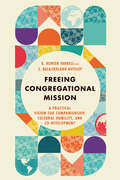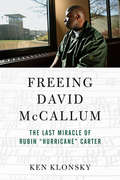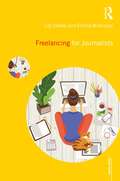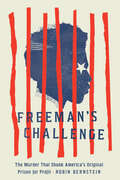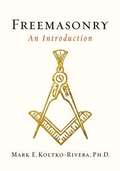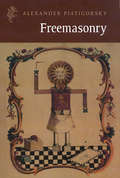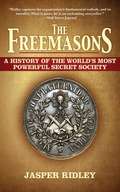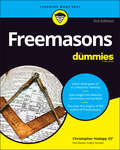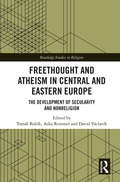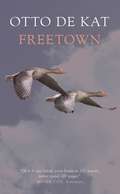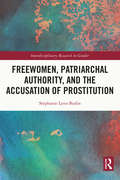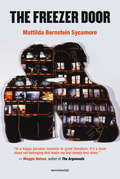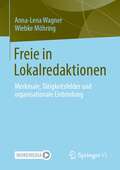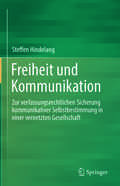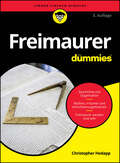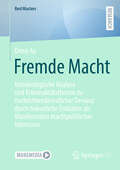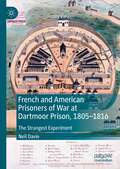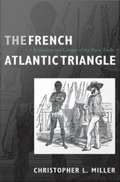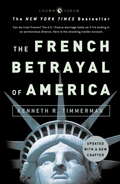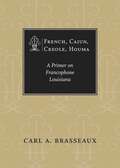- Table View
- List View
Freeing Congregational Mission: A Practical Vision for Companionship, Cultural Humility, and Co-Development
by B. Hunter Farrella Christ-centered theology of mission rooted in companionshipan appetite and competence to engage across differences with cultural humilityinsights and strategies to accompany local and global neighbors in co-development
Freeing David McCallum: The Last Miracle of Rubin "Hurricane" Carter
by Ken KlonskyFor ten years before Rubin "Hurricane" Carter's death, he and his friend and coauthor Ken Klonsky had been working to help free another wrongfully convicted man, David McCallum. McCallum was eventually exonerated and freed after serving twenty-nine years in prison. This is the story of how Carter and Klonsky, along with a group of committed friends and professionals, managed to secure McCallum's release. It details their many struggles, from founding an innocence project to take on the case, finding lawyers willing to work pro bono, and hiring a private detective to sift through old evidence and locate original witnesses, to the most difficult part: convincing members of a deeply flawed criminal justice system to reopen a case that would expose their own mistakes when all they wanted to do was ignore the conflicting evidence. A new district attorney willing to reexamine the case, a documentary film, and an op-ed piece in which Carter, on his deathbed, made a plea for McCallum's release finally turned the tide of justice.
Freelancing for Journalists (Media Skills)
by Lily Canter Emma WilkinsonFreelancing for Journalists offers an authoritative, practical and engaging guide for current and aspiring journalism freelances, exploring key aspects of the role including pitching a story, networking, branding and navigating freelance laws and rights. Featuring case studies from experienced freelance journalists working in the UK, US, Asia and Australia, the book addresses the evolving media landscape and provides valuable tips on how to become established as a successful journalist across a variety of platforms. The authors also explore practical aspects of the trade including tips for setting up a business, managing tax and legal issues, getting paid and earning additional income in related sectors. This book is an invaluable resource for both students and professionals who are interested in taking the next step into freelance journalism work.
Freelancing for Television and Radio
by Leslie MitchellFrom an experienced author in the field, this indispensable guide presents everything needed to create and maintain a successful freelancing career in the world of television and radio. Whether the reader is studying the field, considering their options, or currently employed as a freelance media professional, this book not only gives a brief overview of all areas, but also explains what it means to be freelance in the world of the audio-visual industry. Drawing upon real-life experiences of freelancers and freelance employers, all aspects of the job are detailed, from an outline of tax and employment issues to an analysis of the skills needed to succeed, and all the pitfalls, problems and opportunities which a career in this sector affords are clearly presented. Including: practical advice on how to start, where to find work, writing your CV and networking assessments of related sectors and their opportunities, e.g. facilities and video production an important section on developing and maintaining a freelance career key information on the challenges and responsibilities of setting up a small business a significant chapter on the basics of writing and submitting programme proposals to broadcasters useful contact information. Freelancing for TV and Radio is an absolute must for students of media studies and anyone considering, or already building a career in this hugely popular and fast-growing industry.
Freeman's Challenge: The Murder That Shook America's Original Prison for Profit
by Robin BernsteinAn award-winning historian tells a gripping, morally complicated story of murder, greed, race, and the true origins of prison for profit. In the early nineteenth century, as slavery gradually ended in the North, a village in New York State invented a new form of unfreedom: the profit-driven prison. Uniting incarceration and capitalism, the village of Auburn built a prison that enclosed industrial factories. There, “slaves of the state” were leased to private companies. The prisoners earned no wages, yet they manufactured furniture, animal harnesses, carpets, and combs, which consumers bought throughout the North. Then one young man challenged the system. In Freeman’s Challenge, Robin Bernstein tells the story of an Afro-Native teenager named William Freeman who was convicted of a horse theft he insisted he did not commit and sentenced to five years of hard labor in Auburn’s prison. Incensed at being forced to work without pay, Freeman demanded wages. His challenge triggered violence: first against him, then by him. Freeman committed a murder that terrified and bewildered white America. And white America struck back—with aftereffects that reverberate into our lives today in the persistent myth of inherent Black criminality. William Freeman’s unforgettable story reveals how the North invented prison for profit half a century before the Thirteenth Amendment outlawed slavery “except as a punishment for crime”—and how Frederick Douglass, Harriet Tubman, and other African Americans invented strategies of resilience and resistance in a city dominated by a citadel of unfreedom. Through one Black man, his family, and his city, Bernstein tells an explosive, moving story about the entangled origins of prison for profit and anti-Black racism.
Freemasonry
by Koltko-Rivera Mark E.An experienced Freemason and award-winning psychologist provides a precise and engaging exploration of the core meaning and practices of Freemasonry for the new generation of people interested in joining the order, and those who are simply curious in the wake of recent media coverage. Entertaining books and movies often depict Freemasonry as a shadowy, mysterious, and possibly sinister organization, and the TV and magazine specials on Freemasonry that inevitably follow often leave us with more questions than answers. Mark E. Koltko-Rivera, a practicing thirty-second-degree Mason, has created a simple, authoritative, and easy-to-understand introduction to the history, rites, and meaning of Freemasonry. It may be the single most reliable short guide to Masonry, written by a widely recognized psychologist and scholar of esoteric history. Koltko-Rivera's trustworthy handbook explores all the basic issues around Masonry, like: *What is Freemasonry, and what is its history? *How does one become a Freemason? *What are some of the most important Masonic symbols? *What do Masons get from their involvement in Freemasonry? What changes does it make in their inner and outer lives? *What is it like to participate in the initiatory rituals of Freemasonry? *What are some of the great historical controversies and myths surrounding Freemasonry? *How is Masonry relevant today? .
Freemasonry
by Alexander PiatigorskyThis study considers the institution of Freemasonry from the point of view of both masons and their critics, as well as from the author's own. In the first section, it gives an outline of masonic history, from the foundation of the Grand Lodge in Covent Garden in 1717 through its major role in Enlightenment Europe and the American War of Independence, its many tribulations and schisms in the 19th century to the present day. The book looks at one of the main sources of masonic history, Anderson's "Constitutions", which documents masonic practice and the masons' mythical history back to Hiram Abiff, the first Master Mason in the reign of King Solomon.
The Freemasons: A History of the World's Most Powerful Secret Society
by Jasper RidleyWhat did Mozart and Bach, Oscar Wilde and Anthony Trollope, George Washington and Frederick the Great, Winston Churchill and Franklin D. Roosevelt have in common? They were all Freemasons, a subject of endless fascination. To the layman, they are a mysterious brotherhood of profound if uncertain influence, a secret society purported in some popular histories to have its roots in the fabled order of the Knights Templar, or in the mysteries of the Egyptian pyramids. They evoke fears of world domination by a select few who enjoy privileged access to wealth and the levers of power. The secrecy of their rites suggests the taint of sacrilege, and their hidden loyalties are sometimes accused of undermining the workings of justice and the integrity of nations. Though not a mason himself, Jasper Ridley nonetheless refutes many of the outrageous allegations made against Freemasonry, while at the same time acknowledging the masons' shortcomings: their clannishness, misogyny, obsession with secrecy, and devotion to arcane ritual. In this much-needed reassessment, he offers a substantial work of history that sifts the truth from the myth as it traces Freemasonry from its origins to the present day.
Freemasons For Dummies
by Christopher HodappUnravel the mysteries of the Masons All the myths and rumors about Masonic organizations probably have you wondering "what do Masons really do?" Questions like this one are a natural by-product of being the oldest and largest "secret society" in the world. This book is an ideal starting place to find answers to your questions about the secret and not-so-secret things about Freemasonry. Now in its third edition, this international best-seller peeks behind the door of your local Masonic lodge and explains the meanings behind the rituals, rites, and symbols of the organization. Along the way the book covers nearly 3,000 years of Masonic history, introduces you to some famous Freemasons you already know from history books, and explains the relationship with related groups like Knights Templar, Scottish Rite, Order of Eastern Star, and the beloved fez-wearing Shriners. Look inside the book to learn: What it takes to become a member of the Freemasons, and what you can expect when you join How Lodges are organized and what really goes on during Masonic ceremonies The basic beliefs and philosophies of Freemasonry, including how Masons contribute to charity, and society in general The origins behind some of the wild myths and conspiracy theories surrounding Freemasonry and how to debunk (most of) them Written by a 33rd degree Scottish Rite Mason and the Public Relations and Marketing Director for the Grand Lodge F&AM of Indiana, Freemasons For Dummies is a must-read guide for anyone interested in this ancient fraternal order, whether you're looking to join or are just curious about some of the more mysterious aspects of Freemasonry.
Freemasons For Dummies
by Christopher HodappTake the mystery out of the FreemasonsFascinated by Freemasons? Freemasons For Dummies is the internationally bestselling introduction to the Masons, the oldest and largest "secret society" in the world. This balanced, eye-opening guide demystifies Freemasonry, explaining everything from its elaborate rituals and cryptic rites, to its curious symbols and their meanings.With new and improved content, including updated examples and references throughout, this new edition of Freemasons For Dummies provides the most straightforward, non-intimidating guide to the subject on the market. Updated expert coverage of the basic beliefs and philosophy behind FreemasonryRevised information on the history of the society, including updates concerning its founding, famous historical members, and pivotal eventsNew coverage devoted to the recent influx of younger membershipThe latest and ongoing controversies and myths surrounding FreemasonryThe role of women in a Masonic organization, including opportunities for women to participate in FreemasonryThe effects cultural and political changes and worldwide events are having on the organizationIf you're intrigued by the mystery that surrounds the Masons, get ready to learn the facts about this ancient order in Freemasons For Dummies.
Freethought and Atheism in Central and Eastern Europe: The Development of Secularity and Non-Religion (Routledge Studies in Religion)
This book provides the first comprehensive overview of atheism, secularity and non-religion in Central and Eastern Europe in the twentieth and twenty-first centuries. In contrast to scholarship that has focused on the ‘decline of religion’ and secularization theory, the book builds upon recent trends to focus on the ‘rise of non-religion’ itself. While the label of ‘post-communism’ might suggest a generalized perception of the region, this survey reveals that the precise developments in each country before, after and even during the communist era are surprisingly diverse. A multinational team of contributors provide interdisciplinary case studies covering Estonia, Latvia, Lithuania, Russia, Ukraine, Poland, the Czech Republic, Slovakia, Hungary, Croatia, Romania and Bulgaria. This approach utilises perspectives from social and intellectual history in combination with sociology of religion in order to cover the historical development of secularity and secular thought, complemented with sociological data. The study is framed by methodological and analytical chapters. Offering an important geographical perspective to the study of freethought, atheism, secularity and non-religion, this wide-ranging book will be of significant interest to scholars of twentieth-century social and intellectual history, sociology of religion and non-religion, cultural and religious studies, philosophy and theology.
Freetown
by Otto de Kat"He was a Fula. I say 'was', because I haven't seen him for a long time. I don't know if he's still alive or where he might be. He just disappeared."Maria is independent, unconventional and unafraid. She is trying to find an explanation for the disappearance of Ishmael, a refugee from Sierra Leone who came to her door as a newspaper boy and stayed for seven years. He was like a son to her. Vincent is a psychologist. Once he and Maria had an all-encompassing relationship, but since their break-up he has been living in a kind of haze. One day, Maria asks for his help. In the encounters that follow, Ishmael is pushed into the background by a rekindling of the old love between Vincent and Maria. The stories and memories that resurface come to replace the sadness at the loss of the boy. But despite the distraction of their new situation, Ishmael proves impossible to forget.Otto de Kat is known for concise novels that are beautifully observed, subtle and precise, and Freetown is no exception. Translated from the Dutch by Laura Watkinson
Freetown
by Otto de Kat"He was a Fula. I say 'was', because I haven't seen him for a long time. I don't know if he's still alive or where he might be. He just disappeared."Maria is independent, unconventional and unafraid. She is trying to find an explanation for the disappearance of Ishmael, a refugee from Sierra Leone who came to her door as a newspaper boy and stayed for seven years. He was like a son to her. Vincent is a psychologist. Once he and Maria had an all-encompassing relationship, but since their break-up he has been living in a kind of haze. One day, Maria asks for his help. In the encounters that follow, Ishmael is pushed into the background by a rekindling of the old love between Vincent and Maria. The stories and memories that resurface come to replace the sadness at the loss of the boy. But despite the distraction of their new situation, Ishmael proves impossible to forget.Otto de Kat is known for concise novels that are beautifully observed, subtle and precise, and Freetown is no exception. Translated from the Dutch by Laura Watkinson
Freewomen, Patriarchal Authority, and the Accusation of Prostitution (Interdisciplinary Research in Gender)
by Stephanie Lynn BudinExamining freewomen in Mesopotamian society, ancient Greek hetaira, Renaissance Italy courtesans, historical and modern Japanese geisha, and the Hindu devadāsī of India, Stephanie Lynn Budin makes a wide-ranging study of independent women who have historically been dismissed as prostitutes. The purpose of this book is to rectify a well-entrenched misunderstanding about a category of women existing throughout world history—women who were not (and are not) under patriarchal authority, here called "Freewomen." Having neither father nor husband, and not being bound to any religious authority monitoring their sexuality, these women are understood to be prostitutes, and the terminology designating them appears as such in dictionaries and common parlance. This book examines five case studies of such women: the Mesopotamian ḫarīmtu, the Greek hetaira, the Italian cortigiana "onesta", the Japanese geisha, and the Indian devadāsī. Thus the book goes from the dawn of written history to the present day, from ancient Europe and the Near East through modern Asia, comparatively examining how each of these cultures had its own version of the Freewoman and what this meant in terms of sexuality, gender, and culture. This work also considers the historiographic infelicities that gave rise and continuance to this misreading of the historic and ethnographic record. This engaging and provocative study will be of great interest to students and scholars working in Gender and Sexuality Studies, Women’s History, Classical Studies, Ancient Near Eastern and Biblical Studies, Asian Studies, World Cultures, and Historiography.
The Freezer Door (Semiotext(e) / Native Agents)
by Mattilda Bernstein SycamoreA meditation on the trauma and possibility of searching for connection in a world that enforces bland norms of gender, sexual, and social conformity. <P><P>When you turn the music off, and suddenly you feel an unbearable sadness, that means turn the music back on, right? When you still feel the sadness, even with the music, that means there's something wrong with this music. Sometimes I feel like sex without context isn't sex at all. And sometimes I feel like sex without context is what sex should always be. <P><P>The Freezer Door records the ebb and flow of desire in daily life. Crossing through loneliness in search of communal pleasure in Seattle, Mattilda Bernstein Sycamore exposes the failure and persistence of queer dreams, the hypocritical allure of gay male sexual culture, and the stranglehold of the suburban imagination over city life. Ferocious and tender, The Freezer Door offers a complex meditation on the trauma and possibility of searching for connection in a world that relentlessly enforces bland norms of gender, sexual, and social conformity while claiming to celebrate diversity.
Freie in Lokalredaktionen: Merkmale, Tätigkeitsfelder und organisationale Einbindung
by Anna-Lena Wagner Wiebke MöhringIm Fokus dieser Studie stehen haupt- und nebenberufliche freie Mitarbeiter:innen in Lokalredaktionen von Tageszeitungen und ihren Onlineablegern. Eingesetzt wird ein Mehrmethodenansatz von qualitativen und quantitativen Befragungen, die auf einem sozialintegrativen Theoriemodell basieren. In dem vorliegenden Buch werden die Ergebnisse dieser Befragungen aus Akteurs- und Redaktionsperspektive systematisiert und vorgestellt. Im Zentrum stehen so unter anderem die journalistischen Qualifikationen der Freien, ihre Beziehung zur Lokalredaktion und zur lokalen Umwelt, redaktionelle Richtlinien und Qualitätssicherungsmaßnahmen.
Freiheit und Kommunikation: Zur verfassungsrechtlichen Sicherung kommunikativer Selbstbestimmung in einer vernetzten Gesellschaft
by Steffen HindelangDieses Buch gibt Antworten darauf, wie in Zeiten von Facebook und Fake News der verfassungsrechtliche Schutz des freien öffentlichen Diskurses gelingen kann. Es untersucht, wie die Verfassung auf einen nicht mehr nur durch Rundfunk und Presse klassischen Zuschnitts, sondern auch durch eine Vielzahl Einzelner organisierten massenmedialen Diskurs reagiert und wie das Verständnis der den Diskurs prägenden verfassungsrechtlichen Bausteine aktualisiert werden kann.Die technischen und wirtschaftlichen Bedingungen massenmedialer Kommunikation haben sich fundamental gewandelt. Das vorherrschende verfassungsdogmatische Schutzkonzept – ein „Ersatzmodell von Freiheit“ – kann diesem Wandel nicht ausreichend Rechnung tragen. Der Einzelne muss heute nicht mehr nur vor, sondern auch in seiner Medienmacht geschützt werden. Ausgehend von kommunikationswissenschaftlichen Erkenntnissen wird ein verfassungsrechtliches Verständnis entwickelt, das den Einzelnen wieder ins Zentrum eines freien massenmedialen Diskurses rückt.
Freiheit und Landschaft: Auf der Suche nach Lebenschancen mit Ralf Dahrendorf (RaumFragen: Stadt – Region – Landschaft)
by Olaf Kühne Karsten Berr Corinna Jenal Kai SchusterDas Buch befasst sich mit Fragen der Operationalisierung des Lebenschancen-Ansatzes von Ralf Dahrendorf in Bezug auf räumliche Entwicklungen. Dabei wird untersucht, welche Raumentwicklungen zu einer Maximierung von Lebenschancen beitragen können und welche Raumentwicklungen mit dem Ziel der Maximierung von Lebenschancen zu erstreben sind. Die auf der Idee der Maximierung von Lebenschancen ausgerichtete Raumentwicklung wird dabei an alternativen Weltanschauungen – wie dem klassischen Liberalismus, dem Konservatismus und dem Sozialismus – reflektiert. Der auf die Maximierung von Lebenschancen gerichtete Ansatz der Raumentwicklung wird anhand unterschiedlicher aktueller Herausforderungen exemplarisch dargestellt, etwa der Moralisierung von räumlichen Entwicklungen, der Energiewende, der Kommunikation von Räumen im Internet, Klimawandel und Protesten. Abschließend wird ein Ansatz eines Umgangs mit Raum aus der Perspektive eines Lebenschancen maximierenden Liberalismus erarbeitet.
Freimaurer für Dummies (Für Dummies)
by Christopher HodappWillkommen in der Welt der Freimaurer Geheime Bruderschaften, undurchsichtige Rituale und rätselhafte Symbole – da findet sich reichlich Stoff für Spekulationen und Verschwörungstheorien. »Freimaurer für Dummies« schafft Klarheit. Das Buch beschreibt, wann und warum die Freimaurer gegründet wurden, erläutert die Rituale, erklärt die Symbole und deren Entwicklung über die Jahrhunderte und geht auch auf die unterschiedlichen Verschwörungstheorien ein. Christopher Hodapp, selbst Freimaurer, nennt Künstler und Politiker, die Freimaurer sind oder waren, und beschreibt den Einfluss der Freimaurer auf die heutige Gesellschaft. Sie erfahren Was es mit den Logen auf sich hat Welche Rolle Philosophie und Glaube spielen Welche Regeln Freimaurer einhalten müssen Wie die Freimaurer in Deutschland organisiert sind
Fremde Macht: Kriminologische Analyse und Kriminalitätstheorie zu nachrichtendienstlicher Devianz durch hoheitliche Entitäten als Manifestation machtpolitischer Interessen (BestMasters)
by Deniz AyDieses Buch bietet eine Einführung in die Thematik der nachrichtendienstlichen Devianz durch Emissärinnen und Emissäre, welche aufgrund ihrer Prävalenz für die kriminologische Forschung von hohem Interesse ist. Die Notwendigkeit der Auseinandersetzung ergibt sich aus der bestehenden Forschungslücke bezüglich dieses spezifischen Phänomens, obgleich sich u. a. zahlreiche relevante Ableitungen aus dem kriminologischen Teilbereich der „Kriminalität der Mächtigen“ ergeben. Das Ziel dieser Ausarbeitung ist es, einen tieferen Einblick in den Bereich der Devianz durch hoheitliche (und hoheitlich beauftragte) Entitäten zu gewinnen und eine Kriminalitätstheorie zu entwickeln, welche dieses ubiquitäre Phänomen erklärlich gestaltet. Die gewonnenen Erkenntnisse legen nahe, dass die Dunkelziffer geheimdienstlicher Agententätigkeiten um ein Hundertfaches höher sein könnte als die Zahl der registrierten Fälle. Dieser Deliktsform liegen teilweise sehr unterschiedliche Motivationen zugrunde, weshalb sie von einer großen Varietät von Tatbegehenden verübt wird. Die in diesem Buch konzeptionierte Adversarial Requisition and Access Theory geht von einer Metamotivation aus, die jede Form der nachrichtendienstlichen Devianz für eine fremde Macht und zum Nachteil der eigenen Nation erklärt.
French and American Prisoners of War at Dartmoor Prison, 1805-1816: The Strangest Experiment
by Neil DavieThis book explores the history of Dartmoor War Prison (1805-16). This is not the well-known Victorian convict prison, but a less familiar penal institution, conceived and built nearly half a century earlier in the midst of the long-running wars against France, and destined, not for criminals, but for French and later American prisoners of war. During a period of six and a half years, more than 20,000 captives passed through its gates. Drawing on contemporary official records from Britain, France and the USA, and a wealth of prisoners’ letters, diaries and memoirs (many of them studied here in detail for the first time), this book examines how Dartmoor War Prison was conceived and designed; how it was administered both from London and on the ground; how the fate of its prisoners intertwined with the military and diplomatic history of the period; and finally how those prisoners interacted with each other, with their captors, and with the wider community. The history of the prison on the moor is one marked by high hopes and noble intentions, but also of neglect, hardship, disease and death
The French Atlantic Triangle: Literature and Culture of the Slave Trade
by Christopher L. MillerThe French slave trade forced more than one million Africans across the Atlantic to the islands of the Caribbean. It enabled France to establish Saint-Domingue, the single richest colony on earth, and it connected France, Africa, and the Caribbean permanently. Yet the impact of the slave trade on the cultures of France and its colonies has received surprisingly little attention. Until recently, France had not publicly acknowledged its history as a major slave-trading power. The distinguished scholar Christopher L. Miller proposes a thorough assessment of the French slave trade and its cultural ramifications, in a broad, circum-Atlantic inquiry. This magisterial work is the first comprehensive examination of the French Atlantic slave trade and its consequences as represented in the history, literature, and film of France and its former colonies in Africa and the Caribbean. Miller offers a historical introduction to the cultural and economic dynamics of the French slave trade, and he shows how Enlightenment thinkers such as Montesquieu and Voltaire mused about the enslavement of Africans, while Rousseau ignored it. He follows the twists and turns of attitude regarding the slave trade through the works of late-eighteenth- and early-nineteenth-century French writers, including Olympe de Gouges, Madame de Stal, Madame de Duras, Prosper Mrime, and Eugne Sue. For these authors, the slave trade was variously an object of sentiment, a moral conundrum, or an entertaining high-seas "adventure. " Turning to twentieth-century literature and film, Miller describes how artists from Africa and the Caribbean--including the writers Aim Csaire, Maryse Cond, and Edouard Glissant, and the filmmakers Ousmane Sembene, Guy Deslauriers, and Roger Gnoan M'Bala--have confronted the aftermath of France's slave trade, attempting to bridge the gaps between silence and disclosure, forgetfulness and memory.
The French Betrayal of America
by Kenneth R. TimmermanCan we trust France? Apparently not. After more than 200 years of shared history and interests, the U.S.-France marriage looks as if it's ending in an acrimonious divorce. Here is the shocking insider account.In the wake of French behavior at the United Nations, where Foreign Minister Dominique de Villepin systematically undermined the efforts of Secretary of State Colin Powell to convince the Security Council to authorize force against Iraq, Americans have at best come to suspect our ally of double dealing, and at worst come to view them as the enemy. Almost daily over the past year, new stories have emerged of how the government of French President Jacques Chirac has sought to undermine the U.S. war on terror, publicly sniping at America and inciting other countries to do the same. What's wrong with France? What's behind their recent perfidy? According to bestselling author Kenneth R. Timmerman, the American public doesn't know half the story. After they read The French Betrayal of America, American anger at France will turn to outrage.Timmerman, who worked as a journalist in France for eighteen years and knows the players on both sides, lifts the veil of Jacques Chirac's scandalous love affair with Saddam Hussein, beginning in 1975, when he took him on a tour of top-secret French nuclear facilities. The French attitude toward the dictator, which seemed to baffle American politicians, was in fact entirely predictable. Put bluntly, it was all about money, oil, and guns. Chirac needed Saddam's oil and Saddam's money, and Saddam needed French weapons and French nuclear technology. Despite this, the relationship between France and America was not only amicable but at times very mutually beneficial. That was until the most recent war on Iraq, where France turned the tables, engaging in dirty diplomacy and helping to sway other European countries to their side. French war coverage was not merely one-sided: It was viciously inaccurate, skewed, and openly anti-American. Timmerman also presents incredible new evidence of France's duplicity, including the fact that the French stood to gain $100 billion from secret oil contracts they had concluded with Saddam Hussein.The French Betrayal of America raises questions of whether the nuclear cooperation agreements still in force with the French today should be canceled in light of France's behavior. Our security interests no longer converge, and our economic systems increasingly appear to be at loggerheads. The war in Iraq harshly exposed French treachery and their desire to do business with the worst of international tyrants, putting their economy, their international standing, and their relationship with a 200-year-old friend in severe jeopardy.gainst the Marsh Arabs in southern Iraq to make their region "safe" for French oil engineers.France helped build Saddam's long-range missiles and nukes.Based on exclusive access to new documents, provided by Iraq to the United Nations -- that French defense companies were key partners in helping Saddam Hussein perfect the long-range missiles that killed U.S. soldiers in Saudi Arabia in 1991 and rained terror onto Israel. Chirac has blocked cooperation on a high-profile terrorism case.France's top counter-terrorism judge was ordered to stop cooperating with the United States in the prosecution of Zacarias Moussaoui despite mounds of documents that would have helped the United States to convict Moussaoui of conspiracy to commit mass murder.France illegally sold U.S. military secrets to Saddam Hussein.A prominent French defense company shipped U.S.-designed laser designator pods to Iraq in the 1980s that compromised the most high-tech weapons in the U.S. arsenal.President Mitterrand, a Socialist, became Ronald Reagan's best ally in Europe.The French Betrayal of America reveals the extent of French strategic and intelligence cooperation with the United States at the peak of the Cold War, in areas that will surprise readers on both sides of the Atlantic. The French ran a key agent inside the KGB, whose "cosmic" reach -- right up to the general ...
French, Cajun, Creole, Houma: A Primer on Francophone Louisiana
by Carl A. BrasseauxIn recent years, ethnographers have recognized south Louisiana as home to perhaps the most complex rural society in North America. More than a dozen French-speaking immigrant groups have been identified there, Cajuns and white Creoles being the most famous. In this guide to the amazing social, cultural, and linguistic variation within Louisiana's French-speaking region, Carl A. Brasseaux presents an overview of the origins and evolution of all the Francophone communities.Brasseaux examines the impact of French immigration on Louisiana over the past three centuries. He shows how this once-undesirable outpost of the French empire became colonized by individuals ranging from criminals to entrepreneurs who went on to form a multifaceted society -- one that, unlike other American melting pots, rests upon a French cultural foundation.A prolific author and expert on the region, Brasseaux offers readers an entertaining history of how these diverse peoples created south Louisiana's famous vibrant culture, interacting with African Americans, Spaniards, and Protestant Anglos and encountering influences from southern plantation life and the Caribbean. He explores in detail three still cohesive components in the Francophone melting pot, each one famous for having retained a distinct identity: the Creole communities, both black and white; the Cajun people; and the state's largest concentration of French speakers -- the Houma tribe.A product of thirty years' research, French, Cajun, Creole, Houma provides a reliable and understandable guide to the ethnic roots of a region long popular as an international tourist attraction.
French Criminal Law
by Catherine ElliottThis book provides a clear and accessible account and analysis of French criminal law in English, the first to have been written. French criminal law has been highly influential in the development of criminal law in civil law countries around the world, and a knowledge of French criminal law has become increasingly important in view of the internationalisation and Europeanisation of criminal law. The book provides a historical introduction to the development of French criminal law, and a chapter on French criminal procedure to provide the context for an understanding of substantive criminal law. Subsequent chapters cover the general principles of French criminal law, analysing actus reus, mens rea, parties to crime, inchoate offences and general defences. The major offences are then considered chapter by chapter, and an Appendix provides in both French and English the key provisions of the French Criminal Code.
